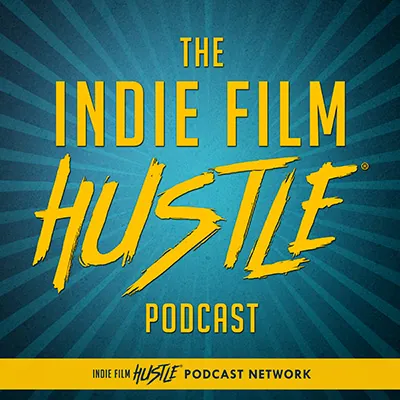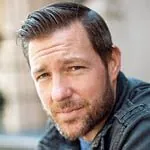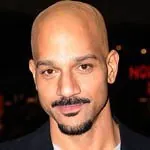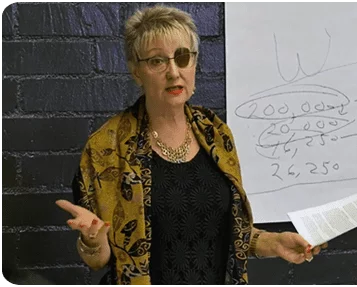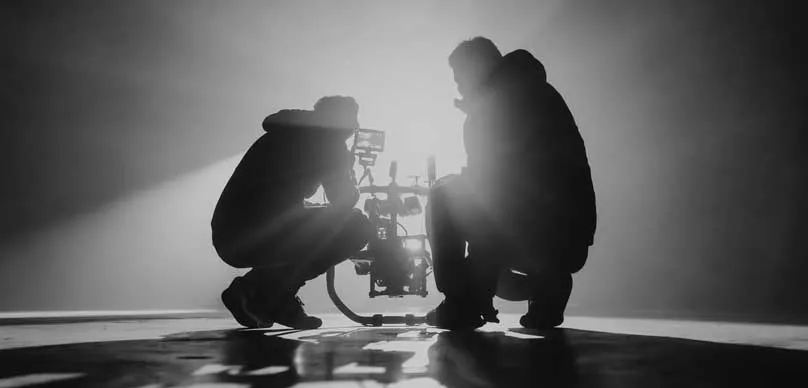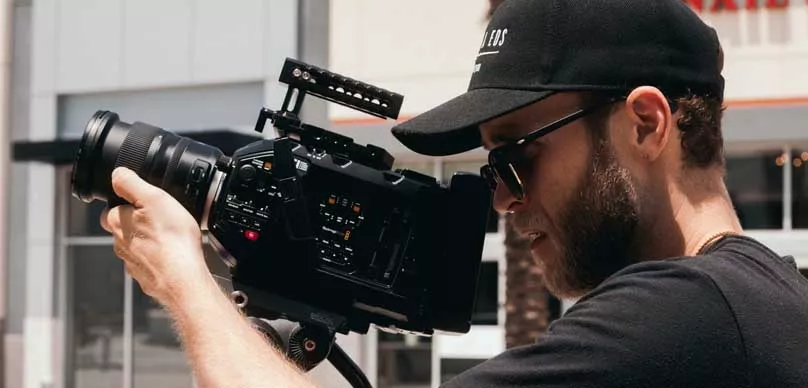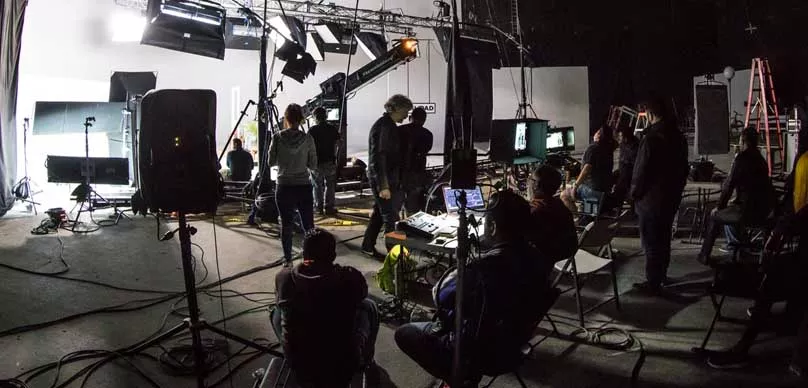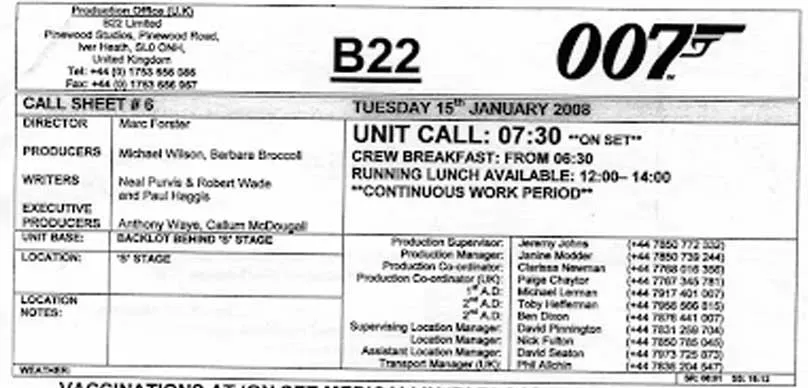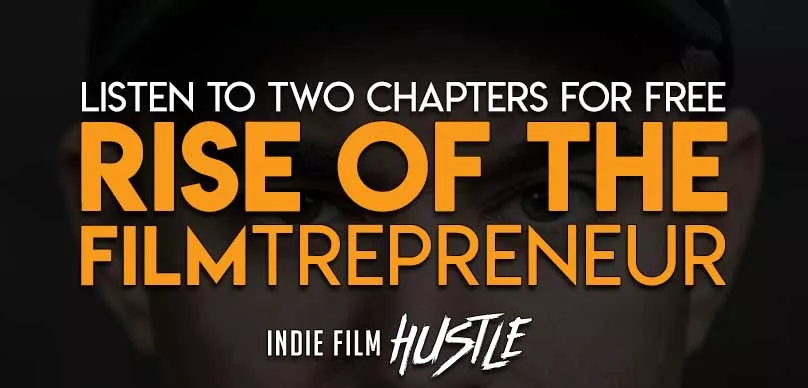Right-click here to download the MP3
Today on the show we have color master Ollie Kenchington. Ollie is a filmmaker, editor, and colorist. He has released an amazing new course called Directing Color. The course focuses on the use of color not only in color grading but also on-set. Since I’ve been a colorist for over a decade I know the importance of color and want to share that info with the IFH Tribe.
Ollie’s company, Korro Films, produces commercials, short films, documentaries and branded content for major international clients, with Ollie Kenchington carrying out senior editor and colorist duties on every project. Ollie Kenchington is an assured practitioner across all areas of filmmaking, giving him a deep understanding of the creative process which allows his agency to flourish in this competitive industry. Additionally, he is an accomplished educator and founder of Korro Academy.
In Directing Color, filmmaker, editor, and colorist Ollie Kenchington explore how visual language cues, color theory, and even color grading techniques can be used throughout the filmmaking process to not just create a “look” but to enhance storytelling. He challenges directors, cinematographers, and filmmakers to think of color first rather than the more common approach of leaving color considerations until post-production.
Enjoy my conversation with Ollie Kenchington.
Alex Ferrari 0:00
I'd like to welcome the show Ollie Kenchington man and thank you so much for taking the time out and jumping on the podcast.
Ollie Kenchington 0:19
It's my absolute pleasure, Alex, it's lovely to speak to you.
Alex Ferrari 3:02
And you know, this is a topic you know, that we have not covered on the show before and it is so important. And it's so powerful. And I know a lot of independent filmmakers just don't understand color. Not only the color grading process, but specifically the theory behind color. So I'm really looking forward to jumping into it with you.
Ollie Kenchington 3:20
Yeah, lovely. Fantastic. I could talk all day about this. So go for it.
Alex Ferrari 3:23
Okay, so how did you first get into the business?
Ollie Kenchington 3:28
Color or just generally feel generally
Alex Ferrari 3:30
Do you as a filmmaker? Yes!
Ollie Kenchington 3:32
Me as a filmmaker. So I studied, I Well, if I go way, way back, which really does kind of say the seeds for where I am right now. I studied astronomy, art and photography at college, which is an unusual mix. And I really didn't know why I was studying that combination of courses back then. He kind of dawned on me much later on that perhaps I quite enjoyed science and art. And that's kind of ultimately what led me into coloring and it seems to me one of the the best kind of disciplines for marrying art and science and the technical with the creative and I picked up as I say stills cameras First of all, but really quite quickly moved into video. I was only doing stills for a couple of years before I got hold of a big s VHS. Big beast off the top of the line that then
Alex Ferrari 4:32
Svhs was the shit.
Ollie Kenchington 4:33
Oh, man. Yeah, absolutely. And I was working with that for a little while and this was this. So I started my degree in 2000. So my degree was a kind of a mix. It was actually an art degree but it was very open. So I basically off of my own volition made it focused on photography and film. And my my final show was a mixture of the two and I, I really kind of enjoyed flitting between the two. And obviously it's such such a cross discipline but with what film opened up for me was the ability to obviously tell that narrative to actually string that story out in a, you know, a linear fashion. And as it really was then linear here, we had tape to tape. But But we were sort of doing it at the time where the cusp of mini DV was just starting to get entrenched. And I remember one day, turning up and the S VHS camera was sort of still in the cupboard and in its place, was this canon XM one? Yes. My University couldn't afford an Excel one. I was about to say. Yeah, much to my annoyance. It was only an art school after all, but I had an accent. And, yeah, I I think the camera itself didn't really excite me at that, at the time, I've got more excited about cameras in more recent years. But at the time, what excited me was the fact that I could take that footage straight into, you know, the power max that we were using back then, and the editing in you know, only real time you know, coming coming, ingesting that and, and starting to edit it, you know, digitally on the computer straightaway. That will not what felt like straightaway anyway, was what opened up the floodgates for me and a lecturer of mine managed to get me a hooky copy of Final Cut Pro. I think it was version two actually, it wasn't version two, it just come out. And that was that. So it's kind of all these things were happening simultaneously. And that was the kind of opening of the door for me. I then used all of my student loan to buy an iMac dv snow, which was the yo Yeah, had FireWire on it that that was
Alex Ferrari 6:48
Oh yeah. Smokin!
Ollie Kenchington 6:50
What more do you need an iMac and an A dv capable camera and, and I was away so I didn't spend I literally just kind of hid away for the next three years of my degree just teaching myself how to edit with Final Cut Pro and making all kinds of weird. I've still got a lot of them and every now and again I watch them just to make myself chuckle but some some very odd art films.
Alex Ferrari 7:16
We all have. We all have a man we all have
Ollie Kenchington 7:18
Yeah, yeah. Oh, my God. Saturday's would classic. And yeah, but you know, it kind of so all came from that there was a bit of a hiccup along the way because I needed money. I quickly realized that, you know, making art films was was never ever going to make me a single penny. So I fell into a job working for Apple, literally straight after I graduated. And yeah, yeah, it wasn't. At the time. It seems odd now but at the time, Apple didn't really exist in the UK in a kind of a bricks and mortar sense. They they relied on this massive network of third party what they call Apple premium resellers, which I think they have in the states as well. Sure. They still kind of exist in this country, or they've been kind of reduced in number by the fact obviously Apple now have these massive Apple Stores everywhere. But yes, a tiny little apple premium reseller in the west southwest of the UK. And they really like the fact that I new Final Cut Pro and the pro video apps and I worked with them for about three years and supporting a lot of post houses in the local area with setting up you know, accents and getting the pro apps system installed.
Alex Ferrari 8:35
You're getting that magic, you're geeking out hard. I love it.
Ollie Kenchington 8:38
I know. It was a crazy time. We were talking about this before you started recording. But we you know we come from a similar kind of period of time with this. It seems crazy now people even people can have like, who in their early 20s are God yet? Remember when Apple were tiny? Like No, no, no, you don't understand. Yeah, we're in the early 2000s this this this company was basically dead. It was bad.
Alex Ferrari 8:59
It was almost It was almost bankrupt. Absolutely. I remember I remember I remember $7 a share for Apple. Yeah. I remember $7 Digi bite them? No, of course now why in god's green when I bought it? Yeah. Now that would be a whole different story. Yes, yes, absolutely. Now when did you get into color grading where you you found a home in color grading as well or added it to your tools are your arsenal of things that you can do?
Ollie Kenchington 9:30
Well, the first time that I actually got hold of some color grading software and and it became accessible to me as a mere human being it was when Apple brought out color. Yeah, of course. So so that that was the first kind of hands on but actually the first time that I decided that I wanted to be a colorist was actually a couple of years were quite a few years before that. I was watching the bonus DVD of the Fellowship of the Ring. And they had that there's a little piece on there. Which is only a short little bit with Peter Doyle, talking to him about how he color graded the film and I was watching I was like what what's color grading? I literally had no idea I'd never heard of it. I'd never kind of contemplated that there was even such a need, you know, surely this stuff came out the camera looking like this, you know? And I'm watching it and I remember it so vividly. There's this bit where he's, you hear him in voiceover talking about them grading legless in the Mines of Moria. And we see legless up on I think it's on like, one of the graves, you know, one of the color tombs, and he jumps off and they're grading his eyes to make them look more kind of blue, because he's an alpha, and they're kind of magical. So, yeah, and I'm like, oh, wow, that's amazing. And then he hits the track button, and it tracks his eyeballs. And as, like a lot of people even today, you know, when they see demonstrations of drinking in Versailles, my mind was, was absolutely blown. I to the point where I I kind of stopped a pizza line, and I managed to find an email address for him and I sent me an email saying, I just want to be a colorist now since I've watched this, you know, how do I become a colorist? And the guy wrote back to me, he's like, we're going to be grading Return of the King soon. Why don't you be my assistant?
Alex Ferrari 11:19
Oh, that's amazing.
Ollie Kenchington 11:25
This This story is I've told this story several times over the years, and it never gets any less painful. So I I'm like, of course yes. That's amazing.
Alex Ferrari 11:35
But he's a news but he's in New Zealand, right?
Ollie Kenchington 11:37
He's in New Zealand. So he's like, yeah, yeah, we're coming up with where and I'm like, Well, I'm in my last year of my degree and and you know, I've got my degree too and she's like, well, that's cool. That'll that'll line up really well with the timings Oh my god, that is perfect. And it got it got kind of a couple of months down the line and his emails were becoming increasingly kind of agitated like you know, if you sorted out accommodation yet and we've got to book flights you know, and I was like, Dude, chill out. You know, this is we got months until I finished my degree and he was What are you talking about? Surely don't you finish in December like we do in New Zealand as I know our academic year ends in June and we were like talking across purposes for months and he will be finished in June you can you feel you either got to just forget your degree and come over or you know, we're just gonna this isn't gonna happen. And
Alex Ferrari 12:28
Please, please don't say it don't say don't go Oh, my God. I decided to finish my let me just remind you my art degree. Oh. It's not like I was training to be a doctor. Your right before you got to to the last. Oh my god. Yeah. No. Have anyone around the slap you? There was no one.
Ollie Kenchington 12:52
No One No One I honestly no one around me had any idea. I was literally the only person that I knew that was even knew that color grading existed who Peter Doyle was so on.
Alex Ferrari 13:03
So what happened when you told Peter Doyle, yeah, thanks for the assistant job, but I'm gonna finish my art degree instead. Yeah, yeah, buddy. Oh, by the way, the Oscar winning third parts of the Lord of the Rings trilogy.
Ollie Kenchington 13:20
Yeah, this story gets worse by the way i just wanted. So I I said, I'm gonna choose to sit my screen and he bless him. He was really supportive. He's like, I totally get it. I think maybe he mistakenly thought I was doing a worthwhile degree. But he is I get it. You know, you finish your studies, you know, maybe we can work on something in the future. Anyway, fast forward a year and I get this email out of the blue. As I said, I wasn't joking when I said I fell straight into a job with Apple after I graduated. It was literally two weeks after my graduation ceremony. I'm now working for Apple. And about six months further down the line. I think I'd already been promoted once it was it was such a massive change point in time where Apple were changing and expanding so quickly. It was you know, I was absolutely caught up in it. And I get this email out the blue from him saying, Ali, I'm coming to the UK. This is perfect. I still need an assistant. I ended up not having one on Return of the King. I definitely need one now. I've got a big big project coming up in London. Yeah, will you join me? Now I don't have a server job.
Alex Ferrari 14:19
I'm just I'm sorry. It's just so painful. It's so painful.
Ollie Kenchington 14:24
This is lightning striking twice in the absolute purest sense. As if the first time of saying no, it wasn't bad enough. This was 10 times worse because by this point, I'm you know what am I 2122 I'm a little bit arrogant now because I've got a pretty damn good job working for Apple. I'll have you know if you're
Alex Ferrari 14:44
21-22
Ollie Kenchington 14:46
I said I sent him an email back saying white No, I've got this. I've got this really good job. And I didn't really want to move to London. I kind of bit of a country bumpkin. I live in the sort of in the countryside in the southwest of the UK as well. I don't ever want to move to London. So I mean, what film is it? Which is like a classic, you know, if you need to know the film, then then just go away. And he would just read back again, really, really nice guy he has to say are like, you know, it sounds like you're, you're sad. Yeah. Don't worry about it. If you need to kind of know what the film is, it's probably not a good fit for you. And, yeah, don't worry about it. Best of luck. And I was so arrogant actually. I just like Yeah, okay. And I literally didn't think about it again for a number of years. Until I until I one day, I don't know why I think I was listening to a podcast, and he came on and he was talking about it. Is that nice career? wise, sir, yeah, it was, it wasn't thankfully. But he didn't mention his assistant a couple of times, who must have been the person he ultimately ended up hiring anyway. And it only dawned on me at that point, that what hit the film he was talking about was the Prisoner of Azkaban. And of course, he went on to do all of the Harry Potter films after that, and countless other films that we could, you know, sit here invest all day. And so I turned down the Return of the King and earned most the vast majority of the Harry Potter films. And And that brings us to today.
Alex Ferrari 16:11
Well, and that's the end of it. And that's the end of the show, guys. Thank you. I wouldn't, I wouldn't blame you for not speaking to me. Now. You know what, but look, I always am a big fan. I'm a big believer that things are supposed to happen the way they're supposed to happen, and you are where you're supposed to be as beautiful as those opportunities might have been. It would be the equivalent of Steven Spielberg calling me up and saying, I need an assistant to come and shadow me on a film I'm doing. And I say, you know what, I'm gonna I'm just gonna stay here in Orlando and finish my degree. Yes, film. Instead of going with you, master Spielberg, it's the equivalent. It's the equivalent of something like that. Twice. Yeah, yeah. Exactly. twice that the twice thing. The twice thing is what really gets me because the first one I could I could say, You know what? Yeah, exactly. Fine. I should start telling the story of leaving out the second part, because we're gonna paint the first one's painful. But yeah, there's some part of you like, you know what, there's a little bit of honor and trying to finish up what you started. I get all that. Yeah. But you know, that goes this man. You carry on with that story. And it's like, this guy's dead. And then, but I think what helps you is that it wasn't like it's someone that it's it's in the behind the scenes. It's like, you know, it's a guy who people don't know, off the street. You know?
Ollie Kenchington 17:40
Yeah, I mean, anyone who knows knows I went to, to the Harry Potter, the Warner Brothers studio tour for Harry Potter. Yeah. Yeah. It leaves them in just outside London.
Alex Ferrari 17:51
Now I want to know, yeah, one in London as well. There's one here in LA. Yeah.
Ollie Kenchington 17:55
Yeah. And I think I was first being the home of Harry Potter. It's a Yeah, I went there with my wife and my eldest child, a few years only a few months ago, actually. And the very last part after you've done the whole tour, and is blown, you're blown away by the very last room, you come to. Everyone just walks through it and just keeps going. But I stopped and I saw this woman sat down. I said, Oh, yeah, what's this room? What's this? The whole room is lined with boxes. And they're meant to be one boxes a bit like you're inside ollivanders. And there's all these different ones. And they all have names on it. As always, what is this? And she said, Oh, it's every single person that over the years, I've had anything to do with the Harry Potter franchise, cast crew, everyone has a one box with their name on it in this room? And, yeah, because it's only like a couple of inches by an inch. You know, these boxes are quite small that there's only a relatively small room. And so many people are streaming through and literally you're like, Oh, I'm at the end, you can see the exit. And off they go. And I'm like, Oh, so I start looking at all of them. And and I know what happened. Do you know where Peter door would be? And she's like, yeah, and she got this massive binder. She's like, right there today today. Anyway, she eventually finds him and points to his box. And I just for a minute as like, in an alternate universe, yes. In this is a wand box with my name on it. Yes. Yes. And I'm not in that universe.
Alex Ferrari 19:23
Well, anyway, I think we've beaten that horse to death. Yeah. Let's move on. We've all made mistakes. Let's move on. So so. So you got into color and you created this amazing course called directing color, which is one of the reasons why I wanted to have you on and to kind of dig into color and how humans deal with color. Well, first of all, how do human beings perceive color in the first place?
Ollie Kenchington 19:50
Well, there's kind of two sides to it. There's the biological side of it. So literally, how do we does the human visual system work? How do we see color and what are the differences? between people and what are the similarities. But then there's also the kind of cultural side of it and what, you know, what we, you know, various societies have come to accept as different meanings associated with the different colors. One of the things that the thing that interests interests me most is, which I discussed in the course is things like, what how we've evolved to pay less attention to certain colors and more attention to other colors, and how that affects our ability to kind of, within if you see these colors within a scene, or a photograph, or a painting, or whatever it might be, how that can cause distancing in some areas and things coming forward in others, and essentially, a way of creating depth just simply by having certain colors in the image. And that, that for me, I think, is fascinating. And we talk in the course about how we've grown evolved to become quite ignorant to blue, for example, because from an evolutionary point of view, there's absolutely no benefit in us being particularly particularly receptive to different shades of blue, the sky is is kind of almost becomes background noise, it's there all the time. We can't, you know, we can't procreate with the sky, although, you know, some people may have tried some, some crazy people, the and we, you know, we and it's also not a threat to us. So those, you know, those those things can you eat it is it going to eat me cannot procreate in it with it. That's the kind of stuff that drives biology and drives evolution. And the sky just doesn't play a part into that. It's also the rarest color in nature, there's very few animals that have lose. Exactly, exactly it. So are the cones in our eyes that are responsible for being receptive to different frequencies of the spectrum, the ones that are responsible for looking at blues, there's only 1% of them. So 99% of our vision, vision is looking at everything other than blue. And so that's why that's why core colors recede, and we, they don't physically receive they, of course, that in our perception, we're just ignoring them. So they, they've become less important to us. And if you look at the other side of that, which is well, what colors come forwards, it's these warm colors, these oranges, these reds, all based around flesh, blood, things that, from an evolutionary point of view are very important that we can distinguish. And the things that we can, you know, kind of our warnings to us, or, you know, we're a social animal, being able to kind of spot other people and, and interact with other people and dangers of you know, your blood. And when you see it, that they they all have these, these effects on us. And, you know, to the point where in some people that that mechanism is a bit over keyed, and, you know, my grandma used to faint if she ever saw blood, and it's actually quite a common thing. You know, that's actually that same mechanism just gone a bit haywire. That's, that's how ingrained in it it is that that these things kind of can produce emotional responses in us and physical responses as well, like high blood, higher blood pressure and elevated heart rate when we see reds is a really interesting phenomenon.
Alex Ferrari 23:10
Yeah, so so how do colors different colors affect different emotions? Because I know, obviously, if you walk into a Red Room, it's a very different feeling than if you walk into a pink room, or a green room or a yellow room. You have a different emotional attachment. So I know there is some attack there is some in theory, color theory, like well, red is this and green means that but it's also cultural as well. It doesn't go across the bow. Yeah. So okay.
Ollie Kenchington 23:42
Yeah, well read is a really good example because of course, in China read means so such different things to what it means in Western culture. And so yeah, I think culture plays a massive part of that, but not just not just your societal culture, but also the culture around how we consume entertainment. So you know, that which is far more kind of international, but you know, going to the cinema and watching TV, there's a there's a visual language that's established over, you know, course of 100 years, which is a language that we're all fluent in. And and it's a language that a lot of people, they can't articulate that they are fluent in that language, but it's there and, and that's always been a, an interesting subject for me, because, and also dangerous subject because, of course, when you do and filmmaking mistakes are not often forgiven very easily by a viewer because they are just so accustomed to watching high quality content. And and those established kind of visual cues and visual language that's there. And this is why, you know, people who don't go to film school have a bit more of a harder time because there's, you can be a very intuitive shooter, you can you can have a natural eye for composition, but there are things that a film school will teach you about visual language and about, you know, how framing so On a certain way, or using a certain kind of focal length of lens can affect people's perception of intention or, you know, if there's kind of a malice or a, you know, an opportunity or a threat or whatever it might be within a scene, and that that's the kind of stuff that, you know, I didn't go to film score, that's the kind of stuff that I've had to, you know, slowly over the last kind of 20 years, kind of get my head around. And, and, and it's taken longer than it would have done if I'd had the opportunity to go to a film school, but it's there, and it's a language that we're all fluent in, but you have to kind of tap into it and unlock it is to kind of, it's almost like a repressed memory there, you got to, you got to kind of tap into that and pull it out and go, alright, that's why this feels a certain way. And kind of definitely part of that.
Alex Ferrari 25:48
There is there's some I was I used to work when I first started out with the old, old time director, who had been doing it for years, and he told me something about color and never forgot. And he goes, if you want your greens to pop the shot before make it red, because the red will stay in your eye when it jumps to the green and enhance the green in a way. And I thought that was fascinating do Can you can you kind of delve into that a little bit.
Ollie Kenchington 26:17
Yeah, so it's basically it's fatigue, so you can fatigue your cones. So the receptors in your eyes are absorbing these, these frequencies. If if they are overstimulated or, or if you're looking at a certain color for for too long, they become fatigued, and they essentially weaken. And when they weaken, they when you sort of look at something else, then that frequency is lessened. And it's I mean, one of the basic tenants of color theory is the idea of complementary colors and what sits opposite a color on the on the color wheel is it's complimentary color. So for example, you This often happens in the summer of your sunbathing or if you're, you know, at the garden, and you've got your eyes closed, there's so much of a particular wavelength of light that's filtering now through your, through your eyelids. So this tinting everything that light light read, that when you then open your eyes, everything looks really green. And it's the same thing, you're fatiguing the red sensory receptors in your eyes or the cones that are looking at that frequency. And then when you then open them up or look at something else, you're then left with that as essentially a weak channel, which makes everything else look stronger. It's not that everything else has become stronger, it's that you've just lessened the response to a certain frequency, which makes everything else look stronger. So red and green, yellow and blue. And it really can work against you when you're calibrating. And in fact, this happened to me recently with rage, where there was a series of shots. And with an interview and absolutely graded, skin tones looked perfect. But the I think it was like the third or fourth time you cut back to this interview, the preceding shot was foliage, it was sunlight coming through some leaves, and it was on screen for maybe five, six seconds. And then when you look at the interview immediately afterwards, it looks like their skin is is all over the place. And it looks like you're the colorist has done a terrible job here. But if you look at those interview shots in isolation, they look absolutely fine. And so you end up having to color great that last interview shot actually differently and essentially deliberately wrong to counteract the sensation of someone having that green fatigue of their eyes when they then cut from that previous shot to the next shot. So it has massive implications on how people perceive your films. And a colorist needs to know this stuff because they need to, they need to kind of hopefully produce something that's consistent all the way through. And continuous contrast is another factor of this. And that that is the phenomenon where surrounding colors around a particular color will alter the way that it looks. And again, that's something that you have to be really conscious of, particularly with interviews with skin tones, you know, what colors are you using as your backdrop what colors are in the scene with your with your talent because they could be making skin tones look wrong when they're not? Or they could be making? You know, bad skin tones look, right, which which is another bad thing? Of course. You know, yeah, basically our eyes are constantly screwing us. And the colorist needs to understand the human visual system and all of these optical effects these tricks that our brains are playing on us and and this is why I said earlier I love the the meeting of kind of science and art and sort of technology and creativity. With color grading for me it's it takes both those boxes and people tend to be left hemisphere dominated kind of creative people or right hemisphere dominated sort of technical or organizational people and it's relatively rare to find people who are both and they hop back and forth between those two kind of parts of their brain very happily but for whatever reason I am one of those people and I do really like being able to play off that deep technical understanding of color and human biology and you know how cameras work, but also then the creative kind of implications and how that's woven into the creative art of filmmaking.
Alex Ferrari 30:13
We'll be right back after a word from our sponsor. And now back to the show. Now, how should a director use or know about color when designing his or her shots in a film? Because it's something really I've seen some directors do it really well, and some not so much.
Ollie Kenchington 30:37
Yeah, I guess the danger of this is that sometimes you can come away with conversations and and it's one of the fears with directing color was that people might come away from it thinking that, oh, everything I've ever made is wrong, because I never thought about this, this, this and this. And I guess really, this is like the, you know, this is like a layer of varnish on the top, you know, it's the the boat if you like, or the the chair or whatever underneath could be just a stable and just a sturdy and just as well crafted, without that extra layer of lacquer. But you know, is it going to win prizes is it going to be one that someone picks over something else. And I think that's that's the thing is all of these techniques are things that are just kind of there honing it and honing it and refining it. And it's just an extra layer of gloss that will help make your product your film stand out above others. And one of the things that people can do is, is obviously focus on lighting, other things people can do is focus on, obviously, you know, wardrobe or art direction, or there's various different parts of a film that one can kind of put energies and resources into thinking that this is what will elevate my film. But the truth of it is that the things that win Oscars and the things that people talk about for years to come and Smashbox off his record, so records are the films that do all of those things, you know, every single element of that an indirect in Colorado, I talk about whiplash. And I think whiplash is a is a fantastic example of a film where every single asset sort of aspect of filmmaking is, is brought together and thought about and you end up with this result on screen. It's so captivating here, the camera movement, the lighting, or in the case of what I'm really interested in the color, and the fact that certain colors are used to kind of signify emotions within the in within the can the main character without you having to say it, you know, without having to spoon feed the audience. So this is where it gets really exciting for directors, I think, because it's an additional weapon in their storytelling arsenal.
Alex Ferrari 32:35
Well, yeah, it's kind of like the olden days, which uses that that language you were talking about, that's been established for over 120 years, which is the black guy, the black, the the guy, the bad guy wears black, and the good guy wears white. And that was in the silent days. That's the way it was, and it was established that way. And then if you know that, you can play on that, where then the black of the the bad guy could wear white, and the good guy could wear black. And you see that constantly going back and forth. And you can start playing with it once you understand it. And it's extremely powerful. It's extremely, extremely is.
Ollie Kenchington 33:09
I think people think that it isn't because it's such it's a kind of a subconscious thing is something that you're not like, you know, even as a colorist, I don't I didn't go and see whiplash the first time and come out thinking, Oh, really interesting that they've put that character in group, same green top that they put the dad's character in it. Now it's only once you kind of go back and digest and, and re analyze these things that you and often when you see stills of them in isolation that you think, Oh shit, yeah, this, they're doing this and they're doing that. I think that doesn't mean it's less valuable. Just because it's unconscious, it means it's more powerful. I think one of the very first sentences that you hear me say in in the directing color series is you 70% of all communication is nonverbal. And that's really, really important that the fact that you're not hearing it or you're not being spoon fed, it doesn't mean that it's less valuable, it means it's more valuable, because we are more accustomed to those subconscious cues than we are verbal and obvious cues. So they are, they should make up, you know, at least 70% of your film. They should make up a big chunk of how you're communicating. You shouldn't feel like it's not worthwhile because it's not in the script, or it's not, you know, obviously up in your face in the scene.
Alex Ferrari 34:25
No, if you look at a movie that we all seen Star Wars, you know, Darth Vader is in black. And you know if Darth Vader was wearing pink, a completely different energy. I've seen that version. Yes, I have actually, I've been to some few Comic Cons myself. Um, but then you've got Luke who's wearing white. You've got Han Solo who's wearing black and white because he's a good guy and a bad guy. You've got Obi Wan, who's wearing Brown, which is an earthy color, which signifies wisdom and then you got Yoda who's green. Which synthesize knowledge and wisdom as well, if I'm not mistaken, that earthly color? And those are kind of certain cues that were associated with those colors? Correct?
Ollie Kenchington 35:09
Yeah, well, particularly me greens an interesting one, because yes, it does. Certainly, if you look over a very broad kind of aggregate, you know, kind of cultural perceptions of green, they green has, obviously, all kinds of connections to do with the natural world do with serenity to do with peace. And, and, you know, kind of like sprites. And, you know, there's, there's loads of different kind of, like Easter, for example, obviously, Christianity kind of bent that towards its own purposes, but celebrations of spring and shine, bringing green things into home, and you know, those those things have gone on for millennia. And there's all kinds of associate positive associations with green but at the same time, just because of, I don't know what it is, I mean, mainly because of skin tones, I think green is something that you don't often see as a color choice in many films, because it because it clashes so terribly with with skin tones, and green is also looks a little bit kind of, I don't know, kind of it can it can very easily veer from kind of fresh spring green to a kind of a horrible kind of muddy green that just doesn't feel good on your
Alex Ferrari 36:23
Pure green, pure green.
Ollie Kenchington 36:24
Yeah, exactly. And, in fact, again, you know, talking of whiplash, in the very last episode of The directing color series, I break down, whiplash and green comes up, because it's used quite heavily in scenes where marsteller, that the main guy in the film, that his character is the, they want to show that his character is being kind of assaulted by these kind of outside pressures. And there's a really good scene at the beginning, where he's walking back to his apartment. And as he's walking through the kind of communal areas, there's lots of loud noises, and there's lots of kind of people and not really doing anything wrong, but clearly he's he doesn't like this, it kind of is ruining his focus as it were. And the whole scenes of vivid green, and they're letting those colors leach into a skin tones. And it's used really effectively in that film to show toxicity and danger. And, you know, this, this kind of sickness that which is which in that film is mainly kind of like a mental synchronous, more mental break. Yeah, and the fact that he does kind of have a breakdown, you know, and ends up hurting himself to try and win the approval of his teacher and, you know, and they but then what they do is they placed that exact same green in the wardrobe of the dad and also the guy who's initially in the band do he has to play better than in order to kind of win his place in the band. And so they both were exactly the same colored green shirt in that film. So green can be used actually and is often used these days as a kind of a bit of a sick kind of color and a bit of a toxic kind of feel to it, which is a mental illness which is an interesting kind of more modern slant on green
Alex Ferrari 38:10
Well against institutional like in a you know, in a mentally and mental Insane Asylum, you're going to see green somewhere.
Ollie Kenchington 38:18
Yeah, in fact, interesting. I've just literally this morning, I've just delivered a project for the Natural History Museum in London, who I am do a lot of work for I was color grading a little piece that they've just done, they've got to show up at the moment called venom. And it's just it's all about different snakes from around the world and, and how and how that venom is used in, in medicines in certain parts of the world and all kinds of stuff. And there's this little film and I was just grading it for them. And I noticed they sent an offline reference that the editor just done a lot of light grade on for me to see the kind of direction that they were heading in about I was essentially creating it from scratch, but just referencing the offline, I noticed that whenever they cut to the B roll of the snake, the snakes kind of shooting venom or in case you know in like they call them aquariums. The snakes live in
Alex Ferrari 39:08
There in zoo's, they're they're in zoo's.
Ollie Kenchington 39:11
But in the Natural History Museum they have they have like them in glass sided.
Alex Ferrari 39:15
Yeah, I forgot. Well, we call them like, I don't even want to call them here. But yeah, I know like that. Yeah. Then anyway, venomous pit I don't know.
Ollie Kenchington 39:22
Yeah, whatever, whatever the hell it is. And I noticed that that the editor pushed quite a bit of green into those shots. And I was like, Okay, I kind of see where they're going with this, but they'd also pushed it into the interviews. And clearly and I hadn't, you know, after having having a chat with them, I could see where they were going through the whole pieces about venom. They wanted to kind of feel like this kind of like dangerous thing. They've got these kind of slow mo shots on the fence and flecks of snakes shooting out of their fangs. But it just felt so wrong with the with the interview. So I ended up pulling it out of all of the interviews and just pushing it into specific scenes and blocks of B roll where it kind of works. And, you know, it's just a little gentle tint of green. And actually, they dialed it back quite a bit. I said to them that you don't need to force feed it to people, you don't need to kind of looked like a comic book the way they'd done it. And, you know, it's just a subtle tint that you pick up on in the highlights and in the whites, and it does the job. You know, it's telling you that this is a kind of a dangerous, sort of toxic substance that they're dealing with.
Alex Ferrari 40:24
Now, besides whiplash, what are some other movies that really are the directors who really use color to great effect?
Ollie Kenchington 40:32
Oh, it's, well, I mean, actually, Peter Jackson is one of the ones that I think is just very clever things with color and color palettes. I always remember it. Sorry, carry on.
Alex Ferrari 40:46
No, no, no, I hear I hear the colors is really good. But I'm sorry. Good. Have it good. Yeah, let's move on. Damnit.
Ollie Kenchington 40:57
The Hobbit is really interesting. I really like the fact that in the hobbit films, there's this color palette that's established, which is pushed into the, the kind of the leaf color. So there's a really, I think it was in one of the trailers. So a lot of people probably seen it, there's a bit where Frodo, Frodo, of course, is Bilbo. Bilbo climbs to the top of a tree to see where they are, they're a little rock in a forest and the last and he climbs to the top of a tree and that scene, where you see the whole of the sort of canopy, the top of the canopy of trees in this big forest. It's so subtle, but the colors are just pushed into a realm of wear, which doesn't mimic our reality, it doesn't mimic our world. And it does a really amazing job of making you feel like you're looking at a fantastical, almost alien landscape. And it's so subtle, it's just very slightly pushed into a, you know, into an area. It's kind of magenta berry reds, and kind of slightly more cyanea greens than than you would expect and that you would see in normal trees on earth. And it's a really interesting use of color to kind of help with that sense of otherworldliness. But with familiar objects, and I think that's used really effectively and Peter Jackson, I think in other films of his, you know, it does some really interesting things with contrast, and with saturation. I can't remember who the name escapes me right now, but I can't remember who directed Tinker Tailor Soldier spa. That's another film that I often reference when I'm thinking about the use of color. And it's how effective it is at storytelling, because it's an interesting because it's a thriller, it's a who've done it. And it kind of comes back to what you're saying earlier about, you know, if the body is always in black, and the good is always in white, what if we play around with that and Tinker Tailor Soldier Spy plays around with the idea of clarity and the idea of high contrast because that we have a measurable pleasure response when we see high contrast images, you can actually see, you know, the the readouts from if you have all those probes on your brain, there's an increase in brain activity, when we see high contrast images, we find the more attractive because the brain is finds it easier to tell if things are in or out of focus if they're high contrast. And of course, contrast plays a big part in autofocus systems in camera so that that edge contrast that detail that sharpness is is is pleasurable to watch. And, you know, you can see this evidenced in photography as well, if you walk down any kind of supermarket or any anywhere where they're selling lots of magazines, you'll see their old glossy covers, they're all high contrast, you know that they're doing everything they can to make those pleasing high contrast images. And then you've got something like Tinker Tailor Soldier Spy, where what they want is for you to constantly feel like you don't know what's going on. It's a it's a thriller, where it's not until then the very last scene that you've read, the reveal happens and most thrillers kind of like to leave clues they like to reward, you know, like doggy treats for the viewer, like all that that's happened, you know that that's a film where they they do everything they can to make sure that doesn't happen. They don't want you having any reason to suspect one person over another. So you go through the whole film wondering, is it Tinker Tailor, Soldier Spy, and one of the ways that they enforce that is by using making the whole thing incredibly low contrast is very gray in that film. And the colors are very muted, and it literally taps into a lack of clarity or the viewer is never given the opportunity to have any clarity on who may have been the perpetrator or who may be this mole. And I think that's a really interesting use of contrast, though, as I said, I can't remember the director's name right now. But yeah, again, there's some great examples out there.
Alex Ferrari 44:52
The the two movies that come to mind always is Emily, which was just stunningly done. Anything that was entered And does because was just call it total trips and the matrix with the matrix look versus the real world look and see, I mean, that look had never I'd never seen anything like the matrix when it came out in 99. Like there was just, and by the way ages so well, I mean, you could watch them right now and it aged super well. But look at that look, which is that technology and sickly like you're not well, like you're not supposed to be here, kind of as opposed to the real world, which is more vibrant and Well, no, that depends on where if you're in the that matrix to then you're in that the rave, which was very nice. But like,
Ollie Kenchington 45:45
That's, that's what I was gonna say. I mean, you're absolutely right. And were aware those scenes change and there's location change, you can see the color developing with the plot. So as the films continue the film, it's not a one trick pony. They're really thinking about how color represents different locations and different you know how they want so you've got lots of browns and reds when they're in you know, as ion and there's loads of tribal kind of music and you know, music and color. These are all things that kind of helping drive that story forwards.
Alex Ferrari 46:13
Have you ever seen the movie Speed Racer? No, I don't think I have. So it's it's warshawsky brother, Sam, guys who directed the matrix, right? Yeah, get it on blu ray, if you can. And because it is easily the most colorful film I've ever seen in my life. And it is, if you remember that cartoon. Yeah, they basically just took the cartoon amped up all the color and saturation, and did such a mess. But it's like, I think the reason why it's so and I love for you to watch and hear what you think of it. I think the reason one of the reasons it didn't do well, because it's actually a good movie, if you know what you're getting into. But yeah, the colors are so vibrant. And so in your face, that I think it was too much.
Ollie Kenchington 47:05
I think it was I say, just quickly googled it and done an image search on Google, which, which by the way is a massive top tip from me, for anyone who's thinking of developing developing mood boards or think planning, you know, China looks with their film, just Google the name of a film or a picture or a photographer or a filmmaker or anyone and just go to the image searches, I can't tell you what an effective way is for quickly, very quickly digesting color palettes. A really good demonstration of this I always like and your viewers, your viewers, your listeners can try this out themselves is to type well make sure they don't do this if they have a sensitive disposition, but to type horror into Google and then just go to the image search. And it's fascinating what you find what you find is essentially blacks whites and red, pure pure primary red. It's It's It's almost, you know, with the odd bit of sort of sick green thrown in, it's, you know, it's fascinating, it's a very good way to get a feel for the general color palettes and looks that are embedded in most of them. So if I type in Speed Racer, and go to an image set, which is what I did last year talking I can see exactly what you mean those vivid comic book blues and reds and sky blues film as well which are
Alex Ferrari 48:17
Put to an extent that it's not it's not even I've never seen before and I don't think it has been was so intense, especially the blu ray. If you watch it on blu ray it is. It's so intense. But I love for you to watch it's it's a fascinating thought, especially with color don't call it great anything after you watch it though your eyes will be wiped for at least a day.
Ollie Kenchington 48:39
I was gonna say it on the on the topic of films where they really go for it with color. I mean, it's like, you know, there's no subtlety involved really at all. Hugo is a classic one. Scorsese goes to town with that and the way it's embedded in the in the art direction in the wardrobe and the makeup and everything. Amazing. Yes, yeah, yeah. Yeah, I know. But I think that the important thing to remember in every single case and every single one of those films we've just mentioned, is the color is serving the narrative. Yes, it's it's it's never there for its own sake. It's never there. Already. Just Just Yeah, exactly. Just to make things look pretty. If you want to make something just look pretty, keep it natural keep skin tones looking normal, make it nice and glossy and high contrast and, you know, add a little bit of golden light into it and you know, Bish, bash Bosh, if you want to try something that serves the narrative and makes people feel a certain way and, and dry is the story and, and in certain cases becomes even a character into its own right, then you know that that's where color can be really powerful.
Alex Ferrari 49:41
There's a scene in I just directed our new film and there's a scene in it where and I colored it as well. Were at the beginning there at the bottom of the hill and at the bottom of the hill. It's all very colorful, but as they go up the hill up these long flight of stairs. It's almost you know, an epic journey. It's Slowly cools all the way to the very top. They're nice, it's cooled, it's muted, and it's subtle. You will, unless you're looking for it, you won't notice it. But it was done very purposefully, because then at that point of the journey, now it starts getting harder and harder, and they're not as happy as they were when they first got on the journey. So
Ollie Kenchington 50:18
Yeah, no, it's a nice trick, it's a really nice, there's so many things that colors can do, it's still it's still so massively under appreciated by fair, which is, you know, not in a nice little you don't appreciate as type way just in a, you never even know you exist,
Alex Ferrari 50:33
I don't even know.
Ollie Kenchington 50:36
I guess it's like the old saying, you know, if you if you notice the editing, then the editor has done a bad job is, is sometimes feels a bit like that. But I do feel like color grading is, is it's becoming so much more part of people's general awareness now at a much lower end of the kind of filmmaker spectrum. And that's because of the point of entry, the price point, and the accessibility of it through things like DaVinci Resolve lite, and, and cheaper hardware that can run, you know, programs that are operating in the 32 bit float, you know, color spaces that that just couldn't happen on, you know, laptops and desktop computers, if you have to go to workstations in the past, and that that's opened up the floodgates in a sense, but that doesn't mean that there suddenly understands everything that we're talking about there. These are things that come through study and through, you know, talking to colorist who've been doing it a long time and research and experience and practice. And this is I guess why I think directing color is is an important call. I mean, I would say this, I made it, but I do think it's.
Alex Ferrari 51:42
So tell us a little bit about the course.
Ollie Kenchington 51:45
Well, it was born out of the fact that means Scott who who runs me said we were chatting about the fact that there were no color grading courses on Amazon at that time. And, you know, there's all lots of practical filmmaking courses. And there were some editing courses. But But color didn't kind of get a look in an eye as a color of thought that that should be addressed. And here's like, fun make us a course. Oh, then it was like, Okay, what do we do? And I guess the obvious thing is to make a straightforward color grading course. And there's a huge appetite for that. And we will be doing that. And we'll be really, you know, going going to town on that side of things and making a big masterclass about color grading. But initially, what I proposed to Scott was that we did something that was shorter and more kind of easily digestible, and kind of got the whole thing kind of conversation started around color. And, and then it was like, Well, what do we choose? And I, the thing that kind of swung it for me was I run a film school or training academy called Cora Academy, and we are a Blackmagic certified training partner, and I'm a Blackmagic certified trainer. So for years now, I've been teaching people DaVinci Resolve, I've been teaching people color grading, and probably the most common thing I get asked about is, you know, from editors, or directors or filmmakers, is I want to learn about color, can you teach me DaVinci Resolve? And over the years, I kind of got sort of bored of sayings, people will hang on, what do you want to do you want to learn how to color or do you want to learn how to operate DaVinci Resolve and in their, in their minds, there wasn't a separation between those two things that as far as I'm concerned, I want to learn how to color great, therefore Teach me DaVinci Resolve, because I will know that that you know that I that's like saying I want to learn about the world and teach me how to drive so that you might only drive to the end of the road. That means you're never going to learn about the world. And it's kind of the same thing. So what I started to do, and I've been doing this for years was I developed a color what I what I called a color theory course. But really it's you know, it's not really it makes it sound a bit dry, but they're actually in color sounds much better. And essentially, it was a one day course I said I didn't insist but I would say to people look, I'd strongly recommend that. If you've never color graded at all. You come on this color theory course first. And we talk about the why first, you know, we talked about why you would want to do something we break down films where this is done. We talk about chroma subsampling. And how do you present division of popular it turned out it's been it's been one of our most popular courses. And so when it came to kind of deciding Well, what should we kind of pick to do as a as a shorter kind of one hour ish course to get things started with them said I thought well that this seems like a good course but you know, is a very dry core. So I had to kind of think of a format for how we could make that more accessible and also just more entertaining Because ultimately, you're asking people to pay money to sit there and watch something for an hour Sharon I should really make something that people want to sit down and watch. And now that's where the idea came to basically piggyback on the on the back of a commercial that my film production company Cora films was making. And so essentially killing two birds with one stone, we were kind of doing a behind the scenes of the shooting a commercial for these for a company. And then we sort of talking to the camera about why I was doing certain things and how we developed a color palette for that film. And then it's intercut with stuff where I'm a grading suite and breaking down, you know, grades. And
Alex Ferrari 55:32
It was, it was it was great, I saw it. And it really is something that we you know, as filmmakers need and I don't think there is much out there about this. But the theory and especially it's done in a very entertaining way. It's very digestible, and you can get in and get out very quickly. And it's it's something that I think you'll become a better director after you watch it. And for everyone listening, I'll definitely put links to the course in the show notes as well. Lovely, lovely. Now, I want to ask you a few questions that I asked all my guests. Okay, this is kind of like the lightning round. What advice What advice would you give a filmmaker wanting to break into the business today? Don't whatever you do, turn down Peter Doyle twice. When opportunity knocks, and the horse is literally have a gift in its mouth. Do not turn away. Okay, great. Can you tell me what book has the biggest impact on your life or career?
Ollie Kenchington 56:32
Oh, that's an interesting one. Well as a colorist, I think one of the one of the books that was instrumental and really helpful when I first thought went from I'm really interested in color and playing with color and to I'm now a professional colorist, and something that really helped me was the colorist handbook. Great witch. Yeah, Alexis van Herman is just the dawn. And that book is just chock full of really useful information. I can't recommend it highly enough. You know, that was that was a huge book for me. In terms of filmmaking, I did by the Peter Jackson's autobiography, which talks about his staying out as a filmmaker and his career goes right from him, you know, messing around making films as a small child
Alex Ferrari 57:25
Horror movie sue, by the way.
Ollie Kenchington 57:27
Yeah, yeah, absolutely.
Alex Ferrari 57:28
Very graphic horror movies. Graphic Yes. If I remember correctly,
Ollie Kenchington 57:32
If you're under 18 don't don't go and watch them straight away. Actually, they they've aged quite badly. So
Alex Ferrari 57:39
They were bad. They were badly age when he made them, sir. Think he would say the same thing? Yeah,
Ollie Kenchington 57:45
Yeah, yeah. Um, but I think that book was was really interesting. I mean, any any book, any biography, Autobiography of filmmakers, I find really fascinating. I just think, you know, directors and filmmakers generally are most often in life, very interesting people and seeing how their careers developed. I think it's really, really fun and informative.
Alex Ferrari 58:08
Cool. Now, what is the lesson that took you the longest to learn whether in the film business or in life?
Ollie Kenchington 58:19
Learning to say no, probably, I'm still quite bad at it. I sometimes feel kind of duty bound to do things for clients or do things for people who aren't even clients that that really anyone else applied? Really? What Why are you? Why are you doing that way, but
Alex Ferrari 58:40
That's how I got you. That's how I got you on the show.
Ollie Kenchington 58:45
Why are you talking to this guy? I mean, I see I see a guy who's clearly in need of some kind of support. I can't help but stop
Alex Ferrari 58:57
Obviously obviously, obviously. Now,
Ollie Kenchington 59:01
I think learning to say no is a really good, a really good thing. In fact, I read something really interesting in about Steve Jobs years ago, which was that he never stayed in a job for for more than a week if you didn't like it and I think generally, you know, I try and kind of remember that and it's sometimes you don't need to know what you want. You just need to know what you don't want and know that you should say no to things that you don't want and know and have faith that ultimately that's going to lead you towards the thing that you did want even if you didn't know what it was
Alex Ferrari 59:32
Very good, very good answer. Now what are three of your favorite films of all time?
Ollie Kenchington 59:37
Oh, my number one these are really these are not filmmakers films. I'm just gonna say this now.
Alex Ferrari 59:43
It's fine.
Ollie Kenchington 59:44
I'm not I'm not going to come up with some
Alex Ferrari 59:46
Citizen. Citizen Kane 400 blows
Ollie Kenchington 59:52
Do you know why just gonna be purely like pure entertainment? Sure. I love I love Wedding Crashers is one of my favorites.
Alex Ferrari 59:59
It's a fun film.
Ollie Kenchington 1:00:06
Really my favorite film is a film which for some reason, still completely gone out of my brain sideways. There we go, Oh, yeah, went sideways is a really underappreciated film. I think it's some of the best writing some of the best acting.
Alex Ferrari 1:00:23
Now Tyler Payne, Sean, fantastic film, fantastic film. And
Ollie Kenchington 1:00:28
I think whiplash has to be in my top three as well, I do. I do really, really like that film. intense. But the thing is, if you if you if you think about it too long, you quite quickly come up a list of about 100 films. But those three that come to mind
Alex Ferrari 1:00:45
Very cool. And now where can people find you online?
Ollie Kenchington 1:00:48
So as I saw, I run two businesses. So from a film production side of view, and for me as a colorist, that all goes through Korro films, which is Korrofilms.com. Korro is spelt in a really stupid way, just to make it harder for people to find me online.
Alex Ferrari 1:01:04
Sure. Fantastic. Marketing. Fantastic.
Ollie Kenchington 1:01:06
Yeah, absolutely. Absolutely. So that's k o double r o, it means nothing. It's a made up word.
Alex Ferrari 1:01:14
It's gibberish. It's absolute gibberish.
Ollie Kenchington 1:01:17
It really is. And so I thought that would be a great thing to use for a business.
Alex Ferrari 1:01:22
And you are you are, you are the the poster child for for high end marketing. I gotta say,
Ollie Kenchington 1:01:31
I really had a business development is my middle name. So yeah korrofilms.com is the film production company. And Coro. academy.com is the film, school we do. We've recently launched an eight week Film Academy, which is very novel is basically every course I've ever taught and everything that lives in my brain about filmmaking, rammed down your throat over every day, five days a week for eight weeks. And yeah, and it's basically meant to be a three year degree in eight weeks. And it's followed up with followed up with a three month mentorship scheme immediately afterwards. And it's kind of it's meant to be my kind of two fingers up to higher education, particularly in this country. And the fact that I don't know what it's like in the States, but in the UK at the moment, if you go to film school, if you go and do a three year degree anywhere, you're coming out with minimum, you know, 30 40,000 pounds worth of debt, which dollars,
Alex Ferrari 1:02:33
That's Yeah, I think it's a lot worse, there isn't, oh, my god, you're talking about 60 to $100,000. So that's, you know, probably like 80,000 pounds.
Ollie Kenchington 1:02:42
The thing is in this country, that's that that model, which we've adopted, but it's only relatively new, so like, even when I went to university, which was only 18 years ago, I left with, I think it was just over 10,000 pounds worth of it's
Alex Ferrari 1:02:56
Exactly how much I left with Yeah, yeah,
Ollie Kenchington 1:02:58
Yeah. which at the time was like, you know, felt like, low, you know, just, it just keeps going up and up and up. But But, you know, I was one of the first people that went to university when you had to pay But literally, like, end of the 90s. And all before that, it was all grant based system, and so you didn't cost you anything to go to university. So it's basically my kind of response to that was, you know, basically Fuck that, let's, let's just cram that information into your head, you can take it and if you can't, then, you know, go go and do another course. But it's a kind of unapologetic film school in eight weeks course. But we also do one, two and three day courses certified black magic courses for resolve, which you take an exam at the end, and you can become a Blackmagic Certified Professional user. So yeah, we do quite a lot.
Alex Ferrari 1:03:47
Very cool. My work, man, Ollie, thank you so much. It has been an absolute pleasure geeking out with you about color, and all sorts of things. And arguably one of the greatest stories of missed opportunity I've ever heard in my life, which I will now recite anytime I speak publicly. Yeah. Ollie, thanks again, man. I appreciate it.
Ollie Kenchington 1:04:11
Pleasure. Thanks so much.
Alex Ferrari 1:04:13
This is what happens when you get to post guys in a room together. We just start talking and talk kid and talk. And by Listen, I hope you guys got a lot out of that episode. Ollie dropped some really great knowledge bombs on the on the tribe today and I just wanted you I hope if you listen to this episode, all the way that you understand the power of color and how to now incorporate color on set in pre production, and also in color grading to really make your films and projects stand apart. Now if you want to link to the course that Ollie created called directing color, just head over to the show notes at indiefilmhustle.com/246 and MZed who is the author of the course as well with Ali is having a sale these next few days. So definitely Take advantage and head over there ASAP. And if you've not already, please head over to filmmakingpodcast.com And leave a five star review for the show. It really helps us out in the rankings and helps us get to more filmmakers. So thank you again, so much for listening guys. And as always, keep that hustle going. Keep that dream alive and I'll talk to you soon.
Sign up to receive email updates
Enter your name and email address below and I'll send you periodic updates about the podcast.
YOUTUBE VIDEO
LINKS
- Directing Color with Ollie Kenchington
- Korro Films
- Ollie Kenchington – Twitter
- [easyazon_link identifier=”B006LXQID8″ locale=”US” tag=”whatisbroke-20″]Amélie[/easyazon_link]
- [easyazon_link identifier=”B001CEE1YE” locale=”US” tag=”whatisbroke-20″]The Matrix[/easyazon_link]
- [easyazon_link identifier=”B001GZ6QDS” locale=”US” tag=”whatisbroke-20″]Dark Knight[/easyazon_link]
- [easyazon_link identifier=”B001H1SVO8″ locale=”US” tag=”whatisbroke-20″]Fight Club[/easyazon_link]
SPONSORS
- Bulletproof Script Coverage – Get Your Screenplay Read by Hollywood Professionals
- Audible – Get a Free Filmmaking or Screenwriting Audiobook
- Rev.com – $1.25 Closed Captions for Indie Filmmakers – Rev ($10 Off Your First Order)

